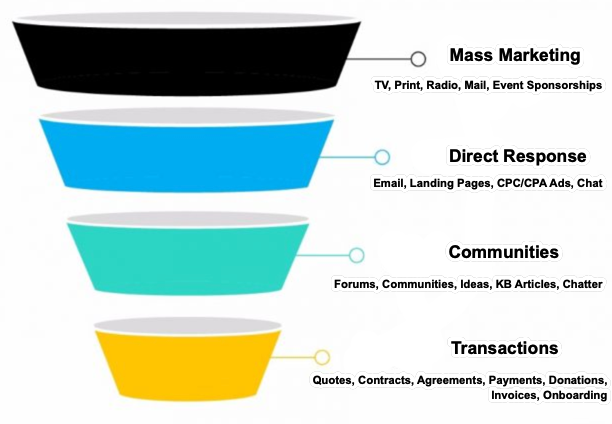|
iDialogue 1.0 launched in 2006 as one of the first apps on the Salesforce AppExchange. At that time, iDialogue was an "enterprise portal" solution with a focus on providing self-service to Salesforce data through a secure website. A recurring pattern emerged among our early adopters. The majority of those visionary customers all implemented some sort of document management solution in their portal. Document-related experiences like generating and delivering quotes, uploading files and resumes, onboarding customers and employees, publishing product guides and manuals, and downloading invoices were common. Now, more than 12 years later, the concept of an enterprise portal has evolved to primarily support direct, personalized, and secure customer transactions. This transaction tier is the final stage in what I'll refer to as the "Customer Dialogue Funnel". At the top of the funnel there are mass marketing campaigns using TV, Print, Radio, and CPM Internet ads. Eventually a more direct dialogue evolves using direct marketing solutions; such as CPC/CPA ad campaigns, landing pages, email and chat. The third layer in the funnel represents community dialogues, where Customers are educating themselves about products, researching reviews and comments, and participating in discussion forums, the Idea Exchange, or Chatter groups. Ultimately these dialogues result in a secure and personalized 1:1 customer experience that involves accepting a quote, signing an agreement, renewing a subscription, submitting a payment, or any number of transactions. We refer to these personalized experiences as "rooms". A well-balanced customer experience architecture will funnel their customers through all 4 stages of the funnel and into "rooms" for direct interactions. iDialogue "rooms" are the personalized transaction layer in this architecture. Customer Dialogue Funnel Mass marketing evolving to personalized, secure transactions. Transactions tend to be document-centric, but may also include payment processing and intake forms. Much of the compliance, regulatory, and governance requirements tend to occur at the transaction layer.
We've rebuilt iDialogue from the ground up with a document-centric focus on the Salesforce Lightning platform. The same portal builder features are included for building secure websites, portals, and landing pages... in what we now refer to as "Room Builder". To achieve a high level of personalization, the Rooms experience is built around the context of a Salesforce record. Every document merge tag, signature, text, image, and piece of content are merged with the Salesforce record. Itemized tables in documents are automatically bound to related child records. The record context can be an Account or Contact with a broad range of available details. Or the room context could be specific to an Opportunity, Quote, Job Offer, or Home Mortgage Loan. Any standard or custom object can be used in a room dialogue. We worked closely with the Salesforce Security Review Team to ensure our frictionless customer onboarding process; using one-time use tokens; is both convenient to customers but secure enough to host the most sensitive documents and transactions. Unlike portals, rooms do not require a username/password. Invitations to rooms are initiated from Salesforce records or flows (however, traditional username/password authentication can be enabled). Messaging and comments are built-in to rooms as more customers expect a messaging app experience when interacting with organizations. The concepts of "redlining" contracts and sending email attachments back forth are progressively moving to shared, online collaboration spaces with secure messaging in the context of a document. Rooms are responsive to both desktop and mobile user experiences. Customers now experience an organization's website and brand through mobile more than ever. Taking a mobile-first approach to iDialogue required completely rethinking basic interactions like previewing documents, eSigning, fillable forms and data entry, and credit card processing. Many Salesforce Veterans and System Administrators will naturally ask how does iDialogue compare to other document solutions like Conga, Drawloop, Spring, Docusign and dozens of others on the AppExchange. Over time it'll become evident that document-driven interactions are just one feature in the rooms customer experience; as are electronic signatures and payments. Ultimately our focus on industry solutions with pre-built accelerators and AI-assisted workflows will be our greatest differentiator. iDialogue's document generation technology certainly has had the benefit of experience, observing the best features in other solutions, and leveraging out-of-box capabilities of Lightning that were not available to competing solutions many years ago when they were pioneering the market. The goal of Customer Relationship Management (CRM) is to facilitate dialogues between an organization and their customers, donors, partners, employees, patients... really any person defined by a Salesforce Lead or Contact. And the role of iDialogue is to provide a Customer Experience Management (CEM) framework for the essential interactions and transactions that occur between a company and a customer.
0 Comments
Your comment will be posted after it is approved.
Leave a Reply. |
AuthorMichael Leach Archives
December 2021
Categories |


 RSS Feed
RSS Feed